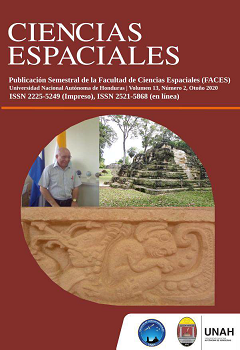Group E and the penances of the Lord of Fire *, AJ Pakal Tahn, Comalcalco, Tabasco
DOI:
https://doi.org/10.5377/ce.v13i2.11260Keywords:
E-Group, Joy´Chan, astronomical equinoxes, temporal equinoxes (quarter-days), Aj Pakal TahnAbstract
This paper refers to the ancient city of Comalcalco, located in the coastal plain of Mexico, just over 17 km south of the Gulf of Mexico, and geopolitically in the Municipality of Comalcalco in the current State of Tabasco. E-Group is an architectural arrangement of at least two structures that has been part of the identity of Mayan culture since the Preclassic Period. It is estimated that the earliest corresponds to the year 900 B.C. or little more, and that they were foundational and commemorative sets as well as multifunctional and public. Everything seems to indicate that they were stopped building during the Early Classic but later, the tradition was retaken, in many of the most powerful cities of the Late Classic. Comalcalco or Joy´Chan was not the exception. Located in a distant enclave, forming part of the northwest border of the Mayan civilization, where it was not built with stone due to its absence but with rammed earth, at some point it acquired the status of one of the powerful cities, along with Palenque, and was the brick the key to building a second constructive, lasting and glorious epoch. It is thought that one of the functions of the E-Groups is associated with the movement of the sky and therefore of the celestial bodies, mainly of the Sun, in relation to the seasons of the year and the agricultural cycle. From the beginning of the century, Comalcalco scholars proposed the idea that E-Group was used as a temporary marker for the penances that a priest, at the service of the city, performed around the March equinox, moment in which it is thought that also as up to date, they were the ones with less rainfall. In this way, the objective of this work has been to evaluate the projections of the set, better known as calendrical-astronomical alignments, and also the dates of the table of the ritual specialist. The methodology consisted of a series of archaeoastronomical measurements in the architectural complex. Among other things, it will be shown how seventeen of the eighteen dates of the priest’s activities could be included in E-Group. In addition, it has been possible to detect a behavior of the dates as a cycle around two types of equinoxes, the astronomical and the temporary, a question, probably unheard of, as well as the December solstice.
Downloads
402




